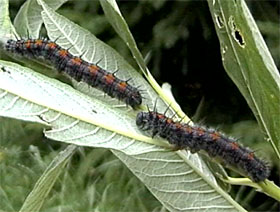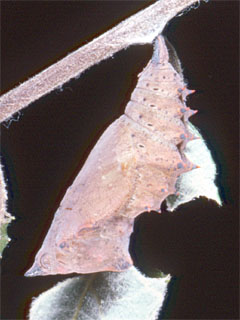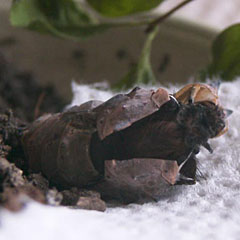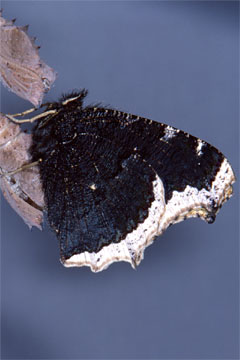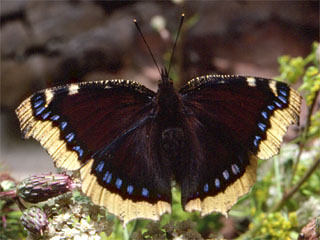The 2010 version of the BNatSchGBundesnaturschutzgesetz of  Germany
Germany Germany (see Bundesministerium für Umwelt, Naturschutz und nukleare Sicherheit) prohibits the removal of specially protected species from the wild and the trade in dead or living individuals of these species.
Germany (see Bundesministerium für Umwelt, Naturschutz und nukleare Sicherheit) prohibits the removal of specially protected species from the wild and the trade in dead or living individuals of these species.
The  Camberwell BeautyNymphalis antiopa (Linnaeus, 1758)Mourning CloakCamberwell Beauty is listed in the Federal Nature Conservation Act as specifically protected (see Protection in Germany (Bundesnaturschutzgesetz)).
Camberwell BeautyNymphalis antiopa (Linnaeus, 1758)Mourning CloakCamberwell Beauty is listed in the Federal Nature Conservation Act as specifically protected (see Protection in Germany (Bundesnaturschutzgesetz)).
In addition to the legal provisions, the question arises as to what extent it makes sense to breed  Camberwell BeautyNymphalis antiopa (Linnaeus, 1758)Mourning CloakCamberwell Beauties at all.
Camberwell BeautyNymphalis antiopa (Linnaeus, 1758)Mourning CloakCamberwell Beauties at all.
Günter EbertGünter Ebert and Erwin RennwaldErwin Rennwald note in Ebert; Rennwald, 1991 - Die Schmetterlinge Baden-Württembergs. Band 1, Tagfalter I, that, not least due to the experiences of Hubert Roer (1926-2002)Hubert Roer Roer, 1981 - Massenwechsel-Untersuchungen an einer Südosteuropäischen Population von Nymphalis antiopa (Lep.: Nymphalidae), breeding the  Camberwell BeautyNymphalis antiopa (Linnaeus, 1758)Mourning CloakCamberwell Beauty for biotope maintenance is not very promising and is always harmful when breeding material is taken from the wild (see also Roer, 1970 - Untersuchungen zum Migrationsverhalten des Trauermantels (Nymphalis antiopa L.) (Lep., Nymphalidae)).
Camberwell BeautyNymphalis antiopa (Linnaeus, 1758)Mourning CloakCamberwell Beauty for biotope maintenance is not very promising and is always harmful when breeding material is taken from the wild (see also Roer, 1970 - Untersuchungen zum Migrationsverhalten des Trauermantels (Nymphalis antiopa L.) (Lep., Nymphalidae)).
In this context, the comment by Helmut KinklerHelmut Kinkler Kinkler, 1996 - Wiedereinwanderung des Trauermantels Nymphalis antiopa (LINNAEUS, 1758) ins nördliche Rheinland und ins westliche Westfalen (Lep., Nymphalidae) is also interesting, who believes that the release of imported butterflies irritates and devalues faunistic research.
 Camberwell BeautyNymphalis antiopa (Linnaeus, 1758)Mourning CloakCamberwell Beauty
Camberwell BeautyNymphalis antiopa (Linnaeus, 1758)Mourning CloakCamberwell Beauty
Camberwell Beauty (Nymphalis antiopa)
[Breeding image]
Breeding: Dieter StüningDieter Stüning
The attempt to recolonise certain areas by releasing bred specimens is highly likely to be doomed to failure. One of many reasons for this is the fact that the adult butterflies are unable to find mating partners in uncolonised areas due to their tendency to migrate. This is probably also one of the reasons why the British Isles do not see any reproduction of butterflies that have flown in.
Perhaps a comprehensive reintroduction of a very large area could deliver a positive result. However, considering the logistical difficulties that would have to be overcome and the incredibly large number of bred butterflies that would be required, this idea also seems unrealistic.
Natural recolonisation, possibly accompanied or supported by human improvement of the conditions for the butterfly, will probably have the greatest probability of success.
Under certain circumstances, it can be advantageous for endangered areas if the populations are replenished with breeding material. This can also include protecting found eggs or caterpillars from parasites and other enemies by further breeding and then releasing the hatched butterflies at the site where they were found. An example of this can be found in Scheel, 2004 - Eine gelungene Zufallszucht von Vanessa antiopa /Trauermantel.
Personally, I cannot see any use for bred adult butterflies that are killed and dissected after hatching - except for scientific purposes.
The following information on the breeding of the  Camberwell BeautyNymphalis antiopa (Linnaeus, 1758)Mourning CloakCamberwell Beauty is largely taken from Friedrich, 1986 - Breeding Butterflies And Moths. Exceptions are labelled.
Camberwell BeautyNymphalis antiopa (Linnaeus, 1758)Mourning CloakCamberwell Beauty is largely taken from Friedrich, 1986 - Breeding Butterflies And Moths. Exceptions are labelled.
Not only due to the laying behaviour of the  Camberwell BeautyNymphalis antiopa (Linnaeus, 1758)Mourning CloakCamberwell Beauty's, in most cases breeding from the egg will only be practised when eggs are laid in captivity.
Camberwell BeautyNymphalis antiopa (Linnaeus, 1758)Mourning CloakCamberwell Beauty's, in most cases breeding from the egg will only be practised when eggs are laid in captivity.
As the eggs are laid as a continuous clutch around thin twigs, it is difficult to remove individual eggs without causing damage.
The removal of a complete clutch or even individual eggs from the wild is prohibited in  Germany
Germany Germany by the BNatSchGBundesnaturschutzgesetz.
Germany by the BNatSchGBundesnaturschutzgesetz.
In my personal opinion, is prohibited even without this law.
 Camberwell BeautyNymphalis antiopa (Linnaeus, 1758)Mourning CloakCamberwell Beauty
Camberwell BeautyNymphalis antiopa (Linnaeus, 1758)Mourning CloakCamberwell Beauty
Camberwell Beauty (Nymphalis antiopa)-caterpillar on Willow (Salix)
The caterpillars, especially in their early stages, react very sensitively to cold or insufficient ventilation. For this reason, sending caterpillars or caterpillars by post is extremely problematic!
As the removal of caterpillars from the wild is prohibited in  Germany
Germany Germany and also in other countries, breeding based on caterpillars will be the exception.
Germany and also in other countries, breeding based on caterpillars will be the exception.
Newly hatched caterpillars initially congregate on a single leaf of the food plant and spread further across the plant as they grow older.
If it is not possible to provide the caterpillars with a (sufficiently large) living food plant, it is advisable to keep individual twigs fresh by watering them.
Suitable forage plants include Crack WillowSalix fragilisCrack Willow (in Ebert; Rennwald, 1991 - Die Schmetterlinge Baden-Württembergs. Band 1, Tagfalter I with reference to Hans-Josef Weidemann (1944-1996)Hans-Josef Weidemann 1980). See also Development: Larval Host Plants.
According to August Johann Rösel (1705-1759)August Johann Rösel, the caterpillars must be supplied with fresh leaves twice a day.
Often several pupated butterflies hatch from the shell at the same time. As they can interfere with each other, the pupation should be animated on rough paper (e.g. attached to the ceiling of the caterpillar box).
Chrysalises that are attached close to each other can then be separated by simply cutting out the paper and then separated and reattached at a safe distance from each other. It is important to ensure that the chrysalises are not pushed or moved too much and that the fine webbing is not loosened at the chrysalis but at the attachment point, as both can be fatal for them Rösel, 1746 - Insecten-Belustigung erster Theil. Der Tagvögel erste Classe. N. 1. Die grosse gesellige Dornen-Raupe mit gelb-rothen Flecken, und ihre Verwandlung bis zum Papilion.
An imminent hatching is indicated by wings shimmering through the pupal skin.
After hatching, the adult butterflies need a few hours until the wings have hardened and the first flight can be started.
Hatching adult butterflies should be given sufficient space to unfold their wings as well as being undisturbed.
 Camberwell BeautyNymphalis antiopa (Linnaeus, 1758)Mourning CloakCamberwell Beauty
Camberwell BeautyNymphalis antiopa (Linnaeus, 1758)Mourning CloakCamberwell Beauty
Camberwell Beauty (Nymphalis antiopa)-chrysalis hanging on a twig
[Breeding image]
Breeding: Dieter StüningDieter Stüning
 Camberwell BeautyNymphalis antiopa (Linnaeus, 1758)Mourning CloakCamberwell Beauty
Camberwell BeautyNymphalis antiopa (Linnaeus, 1758)Mourning CloakCamberwell Beauty
Camberwell Beauty (Nymphalis antiopa) beginning emerging
[Breeding image]
Breeding: Ulrich RauUlrich Rau
 Camberwell BeautyNymphalis antiopa (Linnaeus, 1758)Mourning CloakCamberwell Beauty
Camberwell BeautyNymphalis antiopa (Linnaeus, 1758)Mourning CloakCamberwell Beauty
Camberwell Beauty (Nymphalis antiopa) after emerging
[Breeding image]
Breeding: Dieter StüningDieter Stüning
The females lay their eggs around 10 months after they hatch. In between there is a summer diapausesummer rest and a winter resthibernation.
 Camberwell BeautyNymphalis antiopa (Linnaeus, 1758)Mourning CloakCamberwell Beauty
Camberwell BeautyNymphalis antiopa (Linnaeus, 1758)Mourning CloakCamberwell Beauty
Camberwell Beauty (Nymphalis antiopa)
[Breeding image]
Breeding: Dieter StüningDieter Stüning
The exact time for mating and egg-laying is probably determined by the length of the day and the amount of incident light.
These are not easy tasks for the breeding or further propagation of bred butterflies.
Before adult butterflies overwinter in cold, dark and damp areas, they must be provided with sufficient food for as long as possible.
Mating takes place in spring and can occur naturally or by oviposition (males and females are brought together by hand, slightly anesthetized if necessary) in the case of bred butterflies.








